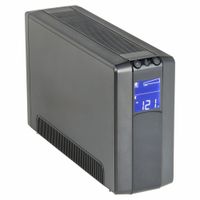Call +(254) 703 030 000 / 751 483 999 / 721 704 777
- Home
- Electrical
- Transformers Ups Power Supplies
- Ups Ups Batteries
.....Read More
Frequently Asked Questions
What is an Uninterruptible Power Supply (UPS)?
An Uninterruptible Power Supply (UPS) is a device that provides emergency power to a load when the input power source, typically the main power, fails. It is a critical component in protecting electronic equipment from power disturbances. A UPS differs from an auxiliary or emergency power system or standby generator in that it provides near-instantaneous protection from input power interruptions by supplying energy stored in batteries, supercapacitors, or flywheels.
The primary function of a UPS is to ensure the continuous operation of connected equipment by supplying power during outages and protecting against power surges, voltage sags, and other electrical anomalies. UPS systems are commonly used to safeguard computers, data centers, telecommunications equipment, and other electrical apparatus where an unexpected power disruption could cause injuries, fatalities, serious business disruption, or data loss.
There are three main types of UPS systems:
1. **Offline/Standby UPS**: Provides basic power protection and is the most cost-effective. It switches to battery power when a power failure is detected.
2. **Line-Interactive UPS**: Offers better protection by regulating voltage fluctuations without switching to battery power, using an autotransformer.
3. **Online/Double-Conversion UPS**: Provides the highest level of protection by continuously converting incoming AC power to DC and then back to AC, ensuring a consistent power supply.
UPS systems are rated by their capacity, measured in volt-amperes (VA) or kilovolt-amperes (kVA), which indicates the maximum load they can support. The runtime of a UPS depends on the capacity of its batteries and the power consumption of the connected devices. Regular maintenance and battery replacement are essential to ensure the reliability and effectiveness of a UPS system.
How does a UPS work?
A UPS, or Uninterruptible Power Supply, is a device that provides emergency power to a load when the input power source, typically the main utility power, fails. It ensures the continuous operation of connected equipment by supplying power from its internal battery. Here's how it works:
1. **Normal Operation**: When utility power is available, the UPS charges its internal battery through a rectifier, which converts AC (Alternating Current) to DC (Direct Current). Simultaneously, it supplies power to the connected devices by converting the DC back to AC using an inverter.
2. **Power Failure**: Upon detecting a power failure or significant voltage drop, the UPS switches to battery mode. The inverter draws power from the battery, converting DC back to AC to maintain power to the connected devices without interruption. This switch is typically instantaneous, ensuring no disruption.
3. **Battery Backup**: The duration for which a UPS can supply power depends on the battery capacity and the load. It provides enough time for safe shutdown of equipment or for auxiliary power sources, like generators, to take over.
4. **Voltage Regulation**: Many UPS systems also offer voltage regulation, protecting against surges, spikes, and brownouts by adjusting the output voltage to a safe level.
5. **Types of UPS**: There are three main types:
- **Standby (Offline)**: Provides basic protection and switches to battery power when a failure is detected.
- **Line-Interactive**: Offers voltage regulation and is suitable for environments with frequent power fluctuations.
- **Online (Double-Conversion)**: Provides the highest level of protection by continuously converting power through the inverter, ensuring a consistent output.
Overall, a UPS is crucial for protecting sensitive electronic equipment from power disturbances, ensuring data integrity, and preventing hardware damage.
How long does a UPS battery last?
A UPS (Uninterruptible Power Supply) battery typically lasts between 3 to 5 years. However, the lifespan can vary based on several factors:
1. **Battery Type**: Most UPS systems use lead-acid batteries, which generally last 3 to 5 years. Lithium-ion batteries, though more expensive, can last up to 10 years.
2. **Usage**: Frequent discharges and recharges can shorten battery life. A UPS that is often used to provide backup power will have a shorter lifespan compared to one that is rarely used.
3. **Temperature**: Batteries perform best at a stable, moderate temperature. High temperatures can significantly reduce battery life, while extremely low temperatures can affect performance.
4. **Maintenance**: Regular maintenance, such as ensuring connections are tight and terminals are clean, can extend battery life. Some UPS systems have user-replaceable batteries, allowing for easy maintenance.
5. **Load**: Operating a UPS at or near its maximum capacity can reduce battery life. It's advisable to use a UPS with a capacity higher than the maximum load to ensure longevity.
6. **Quality**: Higher quality batteries from reputable manufacturers tend to last longer and perform better over time.
7. **Storage**: If a UPS is stored for long periods without use, the battery can self-discharge and lose capacity. It's important to charge stored batteries periodically.
To maximize the lifespan of a UPS battery, it's crucial to follow the manufacturer's guidelines for use and maintenance, monitor the battery's health regularly, and replace it when it shows signs of wear or diminished capacity.
What are the different types of UPS systems?
There are three main types of Uninterruptible Power Supply (UPS) systems:
1. **Offline/Standby UPS**: This is the most basic type of UPS. It provides surge protection and battery backup. Under normal conditions, the device is in standby mode, allowing the main power to flow through. When a power failure occurs, the UPS switches to battery power. This transition is almost instantaneous, but there is a brief delay, typically 2-10 milliseconds, which is usually acceptable for most home and small office applications.
2. **Line-Interactive UPS**: This type of UPS is more advanced than the offline model. It features an automatic voltage regulator (AVR) that corrects minor power fluctuations (such as sags and surges) without switching to battery power. This helps to extend battery life and provides a more stable power supply. The line-interactive UPS is suitable for small businesses and IT applications where power quality is a concern.
3. **Online/Double-Conversion UPS**: This is the most sophisticated and reliable type of UPS. It continuously converts incoming AC power to DC and then back to AC, providing a consistent and clean power output. This design ensures zero transfer time in the event of a power failure, making it ideal for critical applications such as data centers, hospitals, and industrial environments. The online UPS offers the highest level of protection against all types of power disturbances, including blackouts, brownouts, surges, and noise.
Each type of UPS system is designed to meet different needs, balancing cost, complexity, and the level of protection required.
How do I choose the right UPS for my needs?
1. **Determine Power Requirements**: Calculate the total wattage of all devices you need to connect to the UPS. This includes computers, monitors, routers, and any other critical equipment. Add a buffer of 20-25% to accommodate future expansion and ensure the UPS can handle peak power demands.
2. **Decide on UPS Type**: Choose between Standby (Offline), Line-Interactive, and Online (Double Conversion) UPS systems. Standby is suitable for basic protection, Line-Interactive offers better voltage regulation, and Online provides the highest level of protection with zero transfer time.
3. **Consider Runtime Needs**: Determine how long you need the UPS to keep your devices running during a power outage. This is often measured in minutes and depends on the battery capacity. Choose a UPS with sufficient runtime to safely shut down equipment or maintain operations until power is restored.
4. **Check for Surge Protection**: Ensure the UPS offers surge protection to safeguard against voltage spikes. Look for a high Joule rating for better protection.
5. **Look for Additional Features**: Consider features like LCD displays for monitoring, USB connectivity for management software, and audible alarms for alerts. Some UPS models offer network management cards for remote monitoring.
6. **Evaluate Form Factor and Size**: Ensure the UPS fits your space requirements. Tower models are common for desktops, while rack-mounted units are suitable for server rooms.
7. **Assess Brand and Warranty**: Choose a reputable brand known for reliability and customer support. Check the warranty period and what it covers.
8. **Budget Considerations**: Balance your needs with your budget. Higher-end models offer more features and longer runtimes but come at a higher cost.
9. **Read Reviews and Ratings**: Research user reviews and expert ratings to gauge reliability and performance.
10. **Consult a Professional**: If unsure, consult with a professional to ensure you select the right UPS for your specific needs.
How often should UPS batteries be replaced?
UPS batteries should typically be replaced every 3 to 5 years. This timeframe can vary based on several factors, including the type of battery, the operating environment, and the frequency of use. Valve-regulated lead-acid (VRLA) batteries, commonly used in UPS systems, generally have a lifespan of 3 to 5 years. However, factors such as high temperatures, frequent power outages, and improper maintenance can shorten this lifespan.
To ensure optimal performance and reliability, it is crucial to conduct regular maintenance checks. This includes visual inspections for any signs of damage or leakage, testing the battery's voltage and capacity, and ensuring that the UPS system is operating within the manufacturer's recommended temperature range, typically between 20°C to 25°C (68°F to 77°F).
Additionally, many UPS systems come with built-in battery monitoring features that can alert users when the battery is nearing the end of its life. It is advisable to replace the battery as soon as these alerts are received to prevent unexpected power failures.
In environments with critical power needs, such as data centers or hospitals, it may be prudent to replace UPS batteries more frequently or to implement a battery replacement schedule that aligns with the organization's risk management strategy. Regularly updating the UPS system's firmware and ensuring that the batteries are compatible with the UPS model can also help in maintaining the system's efficiency and prolonging battery life.
Ultimately, adhering to the manufacturer's guidelines and conducting regular maintenance are key to determining the appropriate replacement schedule for UPS batteries.
What is the difference between a standby UPS and an online UPS?
A standby UPS, also known as an offline UPS, provides power to connected devices directly from the main power source and switches to battery backup only when it detects a power failure or significant voltage drop. It is typically more cost-effective and energy-efficient, making it suitable for home or small office use where power interruptions are infrequent. The switch-over time from main power to battery is usually a few milliseconds, which is generally sufficient for most consumer electronics but may not be ideal for sensitive equipment.
An online UPS, also known as a double-conversion UPS, continuously powers connected devices from its battery, which is constantly recharged by the main power source. This design ensures zero transfer time in the event of a power failure, providing uninterrupted power supply. It also offers superior protection against power fluctuations, voltage sags, and surges, making it ideal for critical applications such as data centers, medical equipment, and industrial environments. Online UPS systems are typically more expensive and consume more energy due to their continuous operation.
In summary, the key differences lie in their operation and application: standby UPS systems are more economical and suitable for less critical applications with occasional power issues, while online UPS systems provide higher reliability and protection for environments where power quality is crucial.


